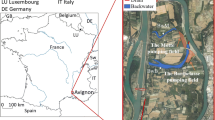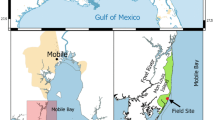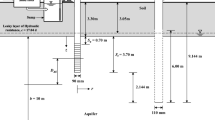Abstract
Two deep-well injection sites in south Florida, USA, inject an average of 430 million liters per day (MLD) of treated domestic fresh wastewater into a deep saline aquifer 900 m below land surface. Elevated levels of NH3 (highest concentration 939 µmol) in the overlying aquifer above ambient concentrations (concentration less than 30 µmol) were evidence of the upward migration of injected fluids. Three pathways were distinguished based on ammonium, chloride and bromide ratios, and temperature. At the South District Wastewater Treatment Plant, the tracer ratios showed that the injectate remained chemically distinct as it migrated upwards through rapid vertical pathways via density-driven buoyancy. The warmer injectate (mean 28°C) retained the temperature signal as it vertically migrated upwards; however, the temperature signal did not persist as the injectate moved horizontally into the overlying aquifers. Once introduced, the injectate moved slowly horizontally through the aquifer and mixed with ambient water. At the North District Wastewater Treatment Plant, data provide strong evidence of a one-time pulse of injectate into the overlying aquifers due to improper well construction. No evidence of rapid vertical pathways was observed at the North District Wastewater Treatment Plant.
Résumé
En Floride du Sud, USA, deux puits profonds injectent dans un aquifère salé à 900 m sous la surface du sol une moyenne quotidienne de 430 millions de litres d’eau usée domestique traitée. Des concentrations élevées en NH3 dans l’aquifère supérieur (concentration maximale 939 µmol), dépassant les valeurs locales (concentration inférieure à 30 µmol) sont des indicateurs de migration ascendante de l’effluent injecté. Trois trajectoires ont été identifiées sur la base des ratios ammonium, chlore et brome, température. Dans l’usine de traitement du District Sud, les ratios traceurs montrent que l’effluent reste chimiquement distinct quand il migre rapidement et verticalement par densité. La migration verticale de l’effluent chaud (moyenne 28°C) est signalée par sa température. La température ne se maintient pas lorsque l’effluent se déplace horizontalement dans l’aquifère supérieur. Une fois introduit, l’effluent se déplace horizontalement dans l’aquifère, se mélangeant avec l’eau en place. Dans l’usine de traitement du District Nord, des données démontrent une injection instantanée de l’effluent dans l’aquifère supérieur en raison d’une construction imparfaite du puits. Dans cette usine, aucun indice de trajectoire verticale rapide n’a été observé.
Resumen
En dos sitios de inyección en pozos profundos, localizados en el sur de Florida, EEUU, se inyecta un promedio de 430 millones de litros por día de agua residual dulce doméstica tratada en un acuífero salino profundo 900 metros debajo de la superficie del terreno. Los elevados niveles de NH3 (la concentración mayor de 939 µmol) en el acuífero suprayacente por encima de concentraciones ambientales (concentración menor que 30 µmol) fueron evidencias de una migración ascendente de los fluidos inyectados. Se diferenciaron tres trayectorias basadas en las relaciones entre amonio, cloruro y bromuro, y la temperatura. En la planta de tratamiento de aguas residuales del Distrito del Sur, las relaciones de los trazadores mostraron que la inyección permanecía químicamente diferenciada a medida que migraba a través de trayectorias rápidas verticales vía la flotabilidad gobernada por la densidad. La inyección más cálida (promedio 28°C) retuvo la señal de la temperatura a medida que verticalmente migraba hacia arriba, mientras que la señal de la temperatura no persistió cuando la inyección se movió horizontalmente dentro de los acuíferos suprayacentes. Una vez introducida, la inyección se movió lentamente en forma horizontal a través del acuífero y se mezcló con el agua ambiental. En la planta de tratamiento de aguas residuales del Distrito Norte, los datos proveen una fuerte evidencia de un pulso único de inyección dentro de los acuíferos suprayacentes debido a la inadecuada construcción del pozo. No se observó ninguna evidencia de rápida trayectoria vertical en la planta de tratamiento de aguas residuales del Distrito Norte.
Resumo
Dois locais de injecção em furos profundos no sul da Florida, EUA, injectam uma média de 430 milhões de litros por dia de água residual doméstica tratada num aquífero salino profundo, a 900 metros de profundidade. Os níveis elevados de NH3 (concentração máxima 939 µmol) no aquífero suprajacente, acima das concentrações habituais (inferiores a 30 µmol), evidenciam a migração ascendente dos fluidos injectados. Identificaram-se três percursos com base nas relações entre os iões amónia, cloreto, brometo, e na temperatura. Na Estação de Tratamento de Águas Residuais de South District, as relações entre os traçadores evidenciam que o fluido injectado continua quimicamente distinto à medida que migra para a superfície através de rápidos percursos ascensionais impulsionados pela diferença de densidades. O fluido quente injectado (média de 28°C) retém o marcador de temperatura à medida que o líquido migra verticalmente para cima; contudo, o marcador de temperatura não persiste no movimento horizontal para os aquíferos superiores. Uma vez introduzido, o fluido injectado move-se lentamente na horizontal através do aquífero e é misturado com a água desse ambiente. Na Estação de Tratamento de South District, os dados obtidos evidenciam claramente que o fluido injectado nos aquíferos superiores é devido a erros de construção do furo. Não há evidência de percursos rápidos verticais na Estação de Tratamento de South District.










Similar content being viewed by others
References
Arthur JD, JB Cowart, AA Dabous (2001) Florida Aquifer Storage and Recovery Geochemical Study: Year Three Progress Report. Open File Report 83, Florida Geological Survey, Tallahassee, FL
BC&E/CH2M Hill (1977) Drilling and testing of the test-injection well for the Miami-Dade Water and Sewer Authority. Contract S-153, BC&E/CH2M Hill, Gainesville, FL
Bloetscher F, Muniz A (2006) Preliminary modeling of class I injection wells in southeast Florida. Ground Water Protection Council 2006 Annual Meeting Proceedings, Miami, FL, November 2006
Bloetscher F, Englehardt JD, Chin DA, Rose JB, Tchobanoglous G, Amy VP, Gokgoz S (2005) Comparative assessment of municipal wastewater disposal methods in southeast Florida. Water Environ Res 77:480–490
Böhlke JK, E Shinn, C Reich, A Tihansky (2003) Origins and isotopic characteristics of dissolved nitrogen species in ground water, imported domestic water, and wastewater in the Florida Keys. US Geological Survey Greater Everglades Science Program: 2002 biennial report. US Geol Surv Open-File Rep 03-54
Böhlke JK, Smith RL, DN Miller (2006) Ammolonium transport and reaction in contaminated groundwater: application of isotope tracers and isotope fractionation studies. Water Resour Res 42, W05411. doi:10.1029/2005WR004349
CH2M Hill (1981) Drilling and testing of the 8 injection wells and the 3 monitoring wells for the South District Regional Wastewater Treatment Plant of the Mimi-Dade Water and Sewer Authority. CH2M Hill, Englewood, CO
CH2M Hill (1998) Engineering report of the construction and testing of the aquifer storage and recovery (ASR) system at the MDWASD West Wellfield. CH2M Hill, Englewood, CO
Clark JF, Bryant Hudson G, Lee Davisson M, Woodside G, Herndon R (2004) Geochemical imaging of flow near an artificial recharge facility, Orange County, California. Ground Water 42:167–174
Corbett DR, Kump L, Dillon K, Burnett W, Chanton J (2000) Fate of wastewater-borne nutrients under low discharge conditions in the subsurface of the Florida Keys, USA. Mar Geochem 69:99–115
Dames and Moore Inc. (1975) Floridan aquifer water supply investigation, Turkey point Area, Miami-Dade County, Florida. Florida Power and Light, Miami
Davis SN, Whittemore DO, Fabryka-Martin J (1998) Uses of chloride/bromide ratios in studies of potable water. Ground Water 36:338–350
Englehardt JD, Amy VP, Bloetscher F, Chinn DA, Fleming LE, Gokgoz S, Solo-Gabriele H, Rose JB, Tchoaboglous G (2001) Comparative assessment of human and ecological impacts for municipal wastewater disposal methods in southeast Florida: deep wells, ocean outfalls, and canal discharges. University of Miami, Coral Gables, FL
Fish JE, Stewart M (1991) Hydrogeology of the surficial aquifer system, Dade County, Florida. US Geol Surv Water Resour Invest Rep 90-4108, 50 pp
Flocks JG, Kindinger JL, Davis JB, Swarzenski P (2001) Geophysical investigations of upward migrating saline water from the lower to upper Floridan Aquifer, Central Indian River Region, Florida. In: US Geological Survey Karst Interest Group Proceedings. US Geol Surv Water Resour Invest Rep 01-4011, pp 135–140
Florida Lakes Power Partners and Florida Power and Light Company (2006) Well completion report for Floridan Aquifer wells PW-1, PW-2 and PW-4, FPL Turkey Point Expansion Project (Unit 5), Homestead, FL
Haberfeld JL (1991) Hydrogeology of effluent disposal zones, Floridan aquifer, south Florida. Ground Water 29:186–190
Hem JD (1985) Study and interpretation of the chemical characteristics of natural water. US Geol Surv Water Suppl Pap 2254
Herczeg AL, WM Edmunds (2000) Inorganic ions as tracers. In: Cook PG, Herczeg AL (eds) Environmental tracers in subsurface hydrology. Kluwer, Norwell, MA, pp 31–78
Kaehler CA, K Belitz (2003) Tracing reclaimed water in Menifee, Winchester, and Perris-South ground-water subbasins, Riverside County, California. US Geol Surv Water Resour Invest Rep 03-4039
Kohout FA (1965) A hypothesis concerning cyclic flow of salt water related to geothermal heating in the Floridan aquifer. Trans NY Acad Sci Ser II 28:249–271
Langmuir D (1997) Aqueous environmental geochemistry. Prentice-Hall, Upper Saddle River, NJ
Maliva RG, CW Walker (1998) Hydrogeology of deep-well disposal of liquid wastes in southwestern Florida, USA. Hydrogeol J 6(4):538–548
Maliva RG, Guo W, Missimer T (2007) Vertical migration of municipal wastewater in deep injection well systems, South Florida, USA. Hydrogeol J 15(7):1387–1396
McNeill DF (2000) Final report: a review of upward migration of effluent related to subsurface injection at Miami-Dade Water and Sewer South District Plant. McNeill, Miami, FL
McNeill DF (2002) A geological review of the confining capability of a regional dolomite unit: application to the MDWASD South District WWTP. McNeill, Miami
Meyer FW (1989a) Hydrogeology, ground-water movement, and subsurface storage in the Floridan aquifer system in southern Florida. US Geol Surv Prof Pap 1403-G
Meyer FW (1989b) Subsurface storage of liquids in the Floridan aquifer system in south Florida. US Geol Surv Open-File Rep 88-477
Miami-Dade Water and Sewer Department (MDAWSD) (1995) Plugging and Abandonment of BZ Well Cluster, South District Wastewater Treatment Plant. MDAWSD, Dade County, FL
Miami-Dade Water and Sewer Department (MDAWSD) (2000) Monitoring well purging report for South District Wastewater Treatment Plant, Miami-Dade Water and Sewer Department, Dade County, Florida. MDAWSD, Miami, FL
Miami-Dade Water and Sewer Department (MDAWSD) (2005) Monitoring well purging report for North District Wastewater Treatment Plant, Miami-Dade Water and Sewer Department, Dade County, Florida. MDAWSD, Miami, FL
Miller JA (1986) Hydrogeologic framework of the Floridan aquifer system in Florida and in parts of Georgia, Alabama, and South Carolina. US Geol Surv Prof Pap 1403-B
Mirecki JE (2004) Water-quality changes during cycle tests at aquifer storage recovery (ASR) systems of south Florida. ERDC/EL TR-04-8. US Army Corps of Engineers, Philadelphia, PA
Mirecki JE (2006) Geochemical models of water-quality changes during aquifer storage recovery (ASR) cycle tests, phase I: geochemical models using existing data. ERDC/EL TR-06-8. US Army Corps of Engineers, Philadelphia, PA
Paul JH, Rose JB, Jiang SC, Zhou X, Cochran P, Kellogg C, Kang JB, Griffin D, Farrah S, Lukasik J (1997) Evidence for groundwater and surface marine water contamination by waste disposal wells in the Florida Keys. Water Res 31:1448–1454
Reese RS (1994) Hydrogeology and the distribution and origin of salinity in the Floridan aquifer system, southeastern Florida. US Geol Surv Water Resour Invest Rep 94-4010
Reese RS (2002) Inventory and review of aquifer storage and recovery in southern Florida. US Geol Surv Water Resour Invest Rep 02-4036
Reese RS, Richardson E (2008) Synthesis of the hydrogeologic framework of the Floridan aquifer system and delineation of a major Avon Park permeable zone in central and southern Florida. US Geol Surv Sci Invest Rep 2007-5207
Renken RA, Dixon J, Koehmstedt J, Lietz AC, Ishman S, Marella RL, Telis P, Rogers J, Memberg S (2005) Impact of anthropogenic development on coastal ground-water hydrology in southeastern Florida, 1900–2000. US Geol Surv Circ 1275
Shinn EA, Reese RS, Reich CD (1994) Fate and pathways of injection-well effluent in the Florida Keys. US Geol Surv Open-File Rep 94-276
Spechler R (2001) The relation between structure and saltwater intrusion in the Floridan aquifer system, northeastern Florida. US Geol Surv Water Resour Invest Rep 01-4011, pp 25–29
Sprinkle CL (1989) Geochemistry of the Floridan aquifer system in Florida and in parts of Georgia, South Carolina, and Alabama. US Geol Surv Prof Pap 1403-I
Starr RC, Green TS, Hull LC (2001) Evaluation of confining layer integrity beneath the South District Wastewater treatment Plant, Miami-Dade Water and Sewer Department, Dade County, Florida. INEEL/EXT-2001-00046, Idaho National Engineering and Environmental Laboratory, Idaho Falls, ID
Stumm W, Morgan JJ (1996) Aquatic chemistry. Wiley, New York
United States Environmental Protection Agency (USEPA) (2003) Relative risk assessment of management options for treated wastewater in south Florida. Office of Water 464-M EPA 816-03-0101, USEPA, Washington, DC
United States Environmental Protection Agency (USEPA) (2008) Underground Injection Control Program. http://www.epa.gov/OGWDW/uic/. Cited 22 January 2008
Walsh V, Price RM (2008) Tracing vertical and horizontal migration of injected fresh wastewater into a deep saline aquifer using natural chemical tracers. In: Proceedings of the 20th Salt Water Intrusion Meeting. Naples, FL, 2008
Acknowledgements
This study was funded by the Miami-Dade Water and Sewer Department (MDWASD). The authors greatly appreciate S. Villamil for her invaluable technical expertise and assistance in the field. We thank C. Powell, S. Kronheim, W. Pitt and B. Goldenberg of MDWASD for their cooperation, and Drs. A. Dausman and C. Langevin of the US Geological Survey for their insightful comments during this research. This report was significantly improved by the thoughtful review of two anonymous reviewers. Dr. Price’s contribution was partially funded by the National Science Foundation Grant No. DBI-0620409. This is SERC contribution #457.
Author information
Authors and Affiliations
Corresponding author
Rights and permissions
About this article
Cite this article
Walsh, V., Price, R.M. Determination of vertical and horizontal pathways of injected fresh wastewater into a deep saline aquifer (Florida, USA) using natural chemical tracers. Hydrogeol J 18, 1027–1042 (2010). https://doi.org/10.1007/s10040-009-0570-8
Received:
Accepted:
Published:
Issue Date:
DOI: https://doi.org/10.1007/s10040-009-0570-8




